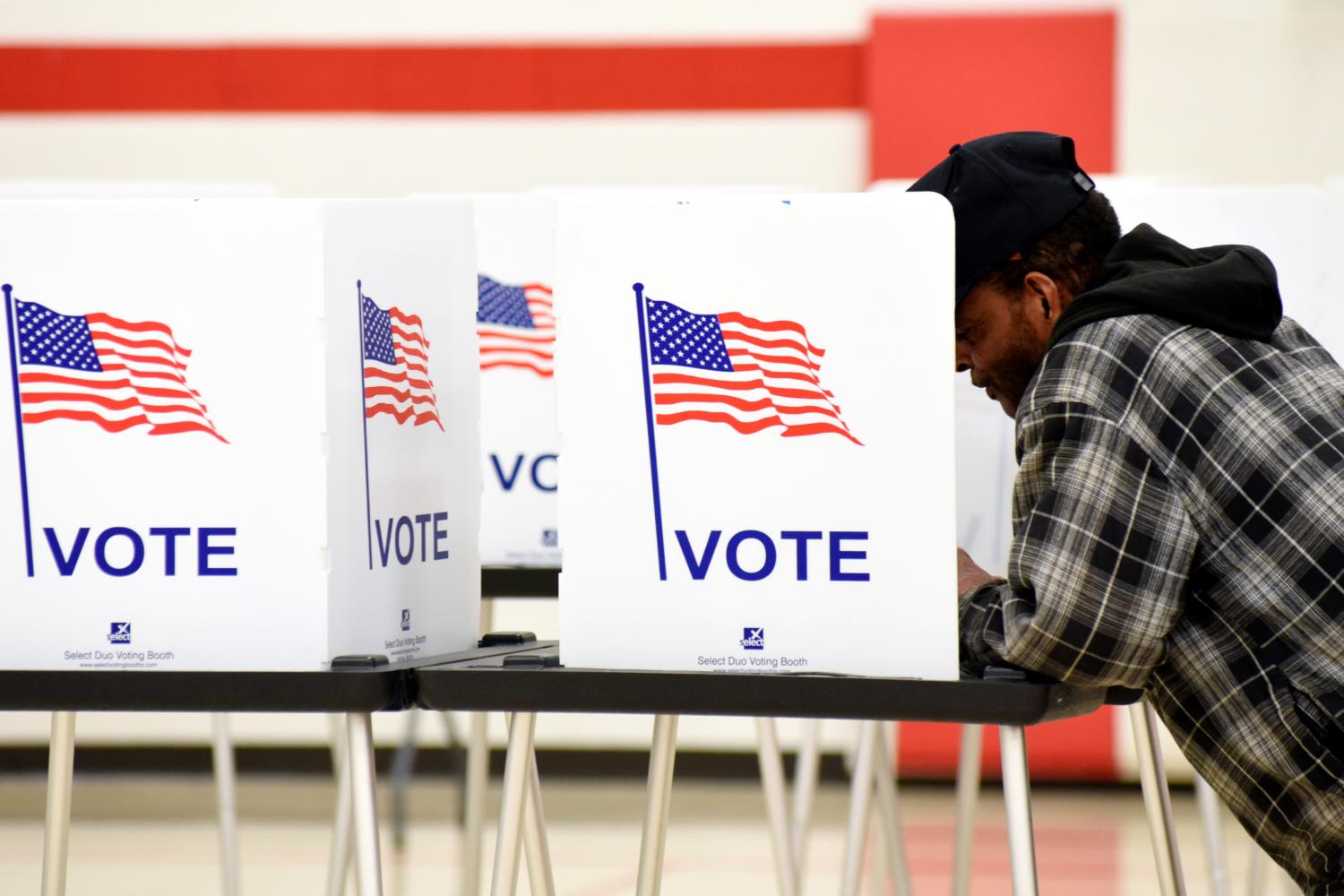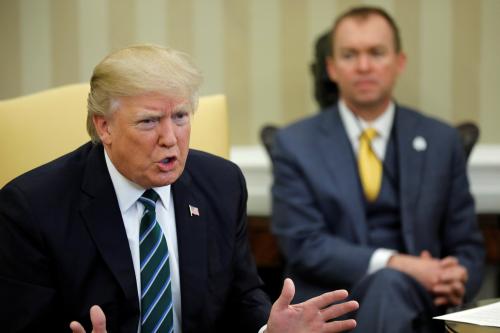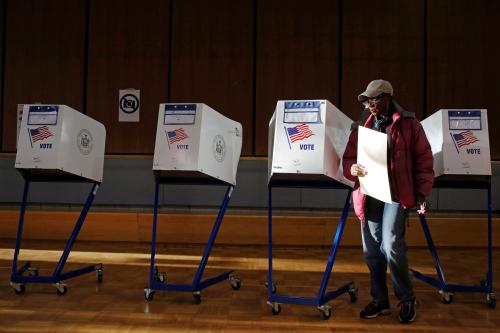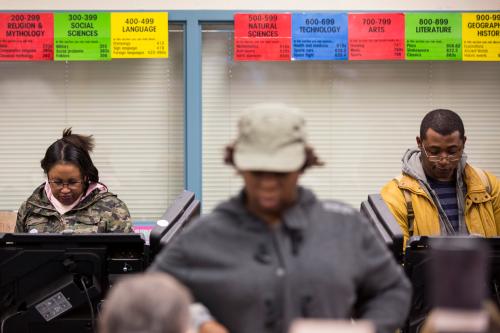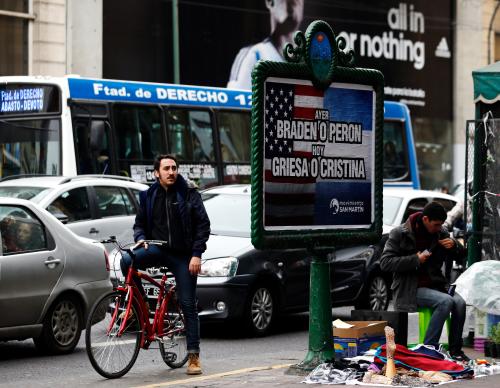This report was updated on November 27, 2018 to reflect the fact that voters in Oklahoma rejected Question 800. Additionally, the appendix has been updated to include new expansionary measures in seven cities.
State and local fiscal policy was not the mobilizing force behind the historic voter turnout of the 2018 elections. Yet policy questions related to public budgets were on state and local ballots across the country, and by showing up in November, voters made decisions that will shape the policymaking landscape of their governments for years to come.
As we have previously described, government revenue structures, and the constraints they operate within, play a crucial role in governments’ ability to provide basic services to constituents and respond to new policy challenges. States that do not levy personal or corporate income taxes, such as Nevada and Texas, or cities that operate under extreme state-imposed limitations on expenditures, such as Denver or Tucson, have less “fiscal policy space” to innovate and govern.
In this light, state and local ballot measures in the 2018 election can be placed into one of two broad categories: those that expand state or local fiscal policy space (which we call “expansionary measures”), and those that restrict state or local fiscal policy space (which we call “restricting measures”). By tracking the results of dozens of state measures and over one hundred local measures in the country’s 100 largest cities, this analysis seeks to understand where voters sought to expand public services, and where they sought to check government spending.
Before delving into the analysis, two brief considerations:
- First, ballot measures are an admittedly imperfect and somewhat controversial policy lever. Just 24 states allow citizen-initiated statutes or constitutional amendments on the ballot; in the remaining 26 states, state legislatures must vote to place measures on the ballot for consideration. Advocates for ballot measures argue that they infuse a necessary dose of popular democracy into our republican form of government, and can be used to raise revenues and pass crucial policies in a time of political gridlock. Critics observe that ballot measures can undermine representative democracy and tie governments’ hands with measures such as California’s Proposition 13. When ballot measures are considered, however, they provide insight into public preferences on many issues, including whether voters prefer to constrain the government’s fiscal behavior or grant it greater fiscal autonomy.
- Second, in general, we view expansionary measures in a positive light, as they grant state and local officials more resources and tools to address today’s policy challenges, at a time when state and local leadership is badly needed. Restricting measures, to the extent that they limit public investment and adaptability, can be counterproductive. That said, given the unique circumstances surrounding each measure, expansionary measures should not be seen as uniformly “good” nor restricting measures uniformly “bad.” To cite two potential exceptions: in Arkansas, voters approved of a measure to license four new casinos. Gambling revenues will contribute to state, county, and city coffers, meaning that this measure expands the fiscal capacities of these governments. Yet critics note that paying for public services with gambling revenues is a regressive, morally questionable, and socially damaging practice. On the other hand, in Nevada, voters approved of sales tax exemptions for feminine hygiene products and medical equipment, measures that limit the fiscal capacity of the state and local governments by narrowing their tax base. Yet advocates for these measures successfully made the case that these exemptions carry significant social benefits that outweigh foregone tax revenue. Still, the broader pattern holds. Most expansionary measures raise new funds through bonds and taxes to invest in critical public assets like schools, transportation networks, housing, and green space, while most restricting measures place broad bans or limits on taxes or increase tax exemptions for property owners.
In the 2018 election, voters in 24 states considered 38 measures that would have expanded the fiscal capacity of state governments, city governments, or both, and 20 measures that would restrict the fiscal capacity for one or more governments. Voters approved of 26 of 38 expansionary measures, and 14 of 20 restricting measures. Additionally, voters in 42 of the 100 largest cities, or the counties that contained them, considered over one hundred ballot measures related to fiscal policy space, nearly all of which were expansionary. Like state measures, local measures had a high rate of success, as approximately 80 percent of measures passed.
Summary statistics only go so far. The following sections explore where fiscally expansionary and restricting measures passed at the state and local level in 2018, and what these policies mean for governments and constituents in the years ahead.
Fiscally expansionary measures in the 2018 elections

Map 1 displays state and local ballot measures in three categories according to the outcome of the vote. States and cities in dark green passed all expansionary measures on their ballots, signaling a strong interest in establishing new or expanding existing public services or facilities. States and cities in light green rejected all expansionary measures on their ballots, signaling voter concerns about increasing the spending power of government. Jurisdictions in medium green, meanwhile, passed some expansionary measures and rejected others, signaling a more nuanced view on public expenditures.
States whose voters passed all expansionary measures
Several of the states whose residents approved all expansionary measures placed bonds on the ballot. Voters in New Jersey passed a bond measure to authorize $500 million for education-related capital projects. In Rhode Island, all three bond measures on the ballot passed, authorizing a total of $367 million to fund investments in K-12 education, higher education, and environmental, water, and recreational capital projects. And voters in New Mexico passed four bond measures that authorize a total of $166 million for public libraries, higher education, tribal schools, school buses, and senior citizen facilities.
Other expansionary states approved new revenue sources or expanded governments’ fiscal flexibility. Michigan voters passed Proposal 1, which legalizes marijuana for recreational use and directs a 10 percent sales tax towards municipalities, counties, school districts, and the state’s transportation fund. By creating a new revenue source, this measure expands the fiscal policy space of the state of Michigan and local governments within it. Oregon voters passed Measure 102, which allows local governments to finance private-sector affordable housing projects with municipal bonds. The measure, strongly supported by the city of Portland and housing advocates, enables local governments to pool municipal funds with federal funds and therefore expands local fiscal flexibility.
Meanwhile, Arizona voters passed Proposition 125, which caps retirement benefits for correctional officers and elected officials, thereby saving state and local governments money at the expense of public sector workers’ retirement security. Georgia voters passed measures to standardize the taxation of forest land and enable local school districts to more easily raise property taxes. And as mentioned earlier, Arkansas voters approved licenses for four new casinos across the state.
States whose voters passed some expansionary measures
Five states passed several expansionary measures but rejected others. Voters in Maine approved four bond measures totaling $200 million for the University of Maine system, the state’s community colleges, transportation infrastructure, and water infrastructure. But they rejected Question 1, which would have created new taxes on payroll and non-wage forms of income to fund a universal home care program. Voters in California passed two of three bond measures on the ballot, authorizing $4 billion for affordable housing programs and $1.5 billion for children’s hospitals, but rejecting an $8.9 billion water infrastructure bond that would have been the second billion-dollar water infrastructure bond approved by California voters in 2018 (a $4 billion bond passed in June). California voters also approved a measure to allow the state to use funds earmarked for mental health services on housing for those individuals, expanding the state government’s budget flexibility. And voters in Montana renewed an expiring property tax directed towards the University of Montana system, but rejected a measure that would have increased taxes on tobacco products to cover costs for the state’s Medicaid expansion.
Utah voters approved two measures to expand the state’s fiscal capacity—legalizing marijuana for medical use and raising the sales tax to support a new Medicaid expansion—but also rejected a non-binding measure that proposed a ten-cent increase to the state’s gas tax.
Lastly, Missouri voters considered three proposals to legalize medical marijuana, rejecting two and passing Amendment 2, which taxes the marijuana industry at 4 percent and directs revenues towards healthcare services, job training, and housing assistance for veterans. Additionally, voters in the state rejected a proposed ten-cent increase in the state’s gas tax by 2022.
States whose voters rejected all expansionary measures
Meanwhile, voters in four states rejected all measures that would have expanded the fiscal capacity of state and local governments. Voters in Colorado rejected a proposal to create tiered income tax brackets, as well as Proposition 110, which would have authorized $6 billion in bonds for transportation projects and raised the sales tax to pay for it. (A second transportation-related bond in Colorado would have required the state to repay debt obligations without raising new taxes, and was therefore categorized as the only “restricting” bond measure this election cycle; it also failed.) North Dakota voters rejected a proposal to legalize marijuana, which would have likely generated new revenue for the state government and localities. Oklahoma voters rejected proposals that would have created a rainy day fund with the state’s oil and gas revenues and enabled the state to use revenue dedicated for school capital projects to fund teachers’ salaries and other operational expenses. Washington, meanwhile, rejected a proposal to implement the nation’s first-ever carbon tax, which would have raised revenue for green energy-related projects.
Nearly all ballot measures related to fiscal space in the country’s 100 largest cities sought to expand, rather than restrict, the fiscal policy space of cities. Voters in 15 of the 100 largest cities passed bond measures to authorize new public spending, while just four cities rejected bond measures: Reno, Nev.; San Jose, Calif.; Toledo, Ohio; and Tucson, Ariz. Voters raised sales taxes in Colorado Springs and Denver, Colo.; Mesa, Ariz.; San Antonio, Texas; and Tampa, Fla. among others, and property taxes in Seattle, Oakland, Los Angeles, Miami, and other cities. Measures in San Francisco and Portland, Ore. to tax big businesses, specifically, also passed, raising new revenue to address homelessness and fund clean energy projects.
Fiscally restricting measures in the 2018 elections

Map 2 focuses on the measures that were fiscally restricting. States and cities in dark orange passed all fiscally restricting measures on their ballots, signaling voters’ interest in reigning in public sector spending and autonomy. States and cities in light orange rejected all restricting measures on their ballots, signaling voters’ concerns that restrictive measures went too far. Jurisdictions in medium orange, meanwhile, passed some restricting measures, and rejected others, signaling a more nuanced view on public expenditures.
Voters in nine states passed all fiscally restricting measures on their ballots. Some of these measures will likely have a limited impact on state budgets. For instance, Virginia’s Question 2 enables spouses of deceased veterans to continue to receive property tax exemptions if they move residences, while Louisiana’s Amendment 6 phases in rapid property tax appraisal increases over a span of four years. Others reduced funding flexibility, but did not reduce state revenue, such as Connecticut’s Transportation Lockbox Amendment, which requires that gas tax revenues be spent on transportation-related projects, or Louisiana’s Amendment 4, which bars the state from using gas tax revenue to fund state police operations.
Other measures, however, appear to carry significant budget limitations. Arizona’s Proposition 126 is a constitutional amendment that prohibits state and local governments from enacting new taxes (or raising tax rates) on services, thereby significantly reducing state and local governments’ fiscal policy space. North Carolina’s Income Tax Cap Amendment lowers the state income tax rate from 10 percent to 7 percent. Georgia’s Referendum A caps property taxes for homeowners in Atlanta, preventing taxes from increasing by more than 2.6 percent annually, and significantly constraining the city’s future property tax revenue.
As the only state that approved several fiscal restricting measures and rejected a third, Florida is in a category of its own. Its voters rejected a measure to expand a property tax exemption that analysts predicted would save homeowners several hundred dollars but lose local governments approximately $645 million in revenue in the first year alone. But they also approved of two measures that significantly constrained the state’s fiscal policy space: Amendment 2, which made permanent a cap on commercial and rental property tax increases, and Amendment 5, which requires a two-thirds vote in both chambers of the Florida legislature to enact new state taxes or fees or increase existing ones. Amendment 5, in particular, constrains the fiscal policy space of the state, as it substantially increases the difficulty of passing tax increases.
Meanwhile, four states rejected all measures that would restrict their fiscal policy space. Voters in California rejected measures that would have expanded property tax exemptions and repealed a recent gas tax increase. Voters in Oregon rejected a measure to preempt the state government and municipalities from taxing soda (while Washington approved a very similar measure). Coloradans rejected a measure to require additional transportation spending by the state. And voters in Utah rejected a constitutional amendment that would have offered property tax exemptions to property owners who rent office space to the state government.
At the local level, just nine ballot measures would have restricted local fiscal policy space. Seven measures passed, including property tax exemptions in Atlanta and Chicago, a balanced budget requirement in Fresno, Calif. and a measure to require that pension funds be used only for pension-related liabilities in San Diego. Voters in Los Angeles and San Antonio, meanwhile, rejected proposals to create a public bank and allow residents to block tax increases, respectively, each of which carry sizable fiscal implications.
Conclusion
Ballot measures are imperfect tools for democratic governance. They are also imperfect measures for assessing a constituency’s collective mood towards public investment, taxation, service delivery, and fiscal policy. As can be seen in California, Montana, Maine, and other states whose voters approved of some expansionary measures and rejected others, an initiative’s success relies on numerous factors beyond broad views on public investment. How new revenues are raised matters a great deal, as does how proposed investments would be spent; who supports or opposes a ballot measure, historical precedents for similar proposals, and the specific wording of ballot question also likely play crucial roles in determining a measure’s passage. Nevertheless, this analysis of 2018 state and local ballot measures reveals four takeaways:
- Fiscal policy doesn’t neatly follow partisan lines. While Democrats tend to display a greater willingness to raise taxes and increase public investments than do Republicans, fiscally expansionary measures in blue states like Washington and Colorado failed in 2018, while red states like Utah and Missouri legalized and established taxes on marijuana for medicinal purposes (even if both states did also reject gas tax increases).
- That said, states in 2018 rarely passed both fiscally expanding and restricting measures. Of the seven states that considered both expansionary and restricting measures, just Arizona and Georgia approved both sets of measures. Even then, the fiscally expansionary measures undertaken by both states were ones that would appeal to a fiscally conservative constituency, as the states cut pension benefits for public sector workers and empowered municipalities to more easily raise property taxes, respectively.
- Borrowing money for capital projects remains more politically popular than tax increases. Fourteen of 17 state bond measures passed, compared with just seven of 16 proposed tax increases. At the local level, 43 of 47 bond measures passed (91 percent), compared with 26 of 35 proposed tax increases (74 percent).
- States are more likely to consider fiscal limitations than cities or counties. Approximately one-third of state measures related to fiscal policy in 2018 restricted the fiscal policy space of states or cities, compared with just 8 percent of local measures within the largest 100 cities. This is consistent with past research that cities largely operate under constraints imposed by state governments. In turn, cities are more likely than states to seek and receive approval from voters to gain new fiscal capacities.
Few voters show up on Election Day specifically to weigh in on fiscal policy. Yet the investments and regulations approved through state and local ballot measures do matter. The day after the election, California’s state leaders began preparing to invest $5.5 billion in affordable housing projects and children’s hospitals; that same day, Florida’s leadership faced the prospect of needing supermajorities in the Republican-controlled legislature to approve tax increases if times got tough. By shaping the ability of states and cities to invest in public assets, these measures affect the quality of life, amenities, and economic opportunities within cities and regions, defining their economic trajectories for years to come.
Thanks to Andrea Garcia for excellent research assistance on this post.


